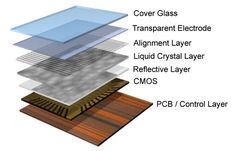Liquid-Crystal-on-Silicon (LCOS) Microdisplays
 LCOS (Liquid Crystal on Silicon) is a reflective microdisplay technology based on a silicon backplane. The electronic circuits controlling the liquid crystals are fabricated on a silicon chip, which is coated with a highly reflective surface. This results a very high image quality (the image is less pixelated) because the circuitry is behind the pixel (compared with transmissive Liquid Crystal (LC), where electronics surround the pixels) and does not create an obstruction in the light path (“screen door” effect). Using standard CMOS processes, microdisplays with extremely small pixels, high fill factor (pixel aperture ratio), and low fabrication costs are realized.
LCOS (Liquid Crystal on Silicon) is a reflective microdisplay technology based on a silicon backplane. The electronic circuits controlling the liquid crystals are fabricated on a silicon chip, which is coated with a highly reflective surface. This results a very high image quality (the image is less pixelated) because the circuitry is behind the pixel (compared with transmissive Liquid Crystal (LC), where electronics surround the pixels) and does not create an obstruction in the light path (“screen door” effect). Using standard CMOS processes, microdisplays with extremely small pixels, high fill factor (pixel aperture ratio), and low fabrication costs are realized.
LCOS microdisplay technology has several advantages over other display technologies where high performance, such as extremely high brightness, contrast, and/or resolution, is required.
Advantages of LCOS:
- Ultra high brightness, while retaining high contrast (up to 2000:1 with no “red box” at high brightness)
- High efficiency (70-80%+ of light in makes it out)
- Heating efficiency (heater covers entire rear instead of just the edges)
- High quality film-like image (no “screen door” between pixels)
- LCOS is highly scalable and can create very small pixels, also well suited for laser projection
- LCOS can modulate amplitude, polarization ,and phase opening up possibilities other displays cannot achieve, such as Fourier “no optic” imaging and true holographic displays.
Overview of the currently available LCOS displays:
http://holoeye.com/lcos-microdisplays
Further customization options are available. HOLOEYE Systems, Inc. offers a variety of custom backplanes, application specific liquid crystal, amplitude/phase modes, and other characteristics. Please contact us with your requirements.
